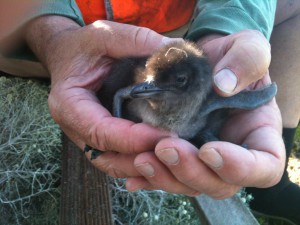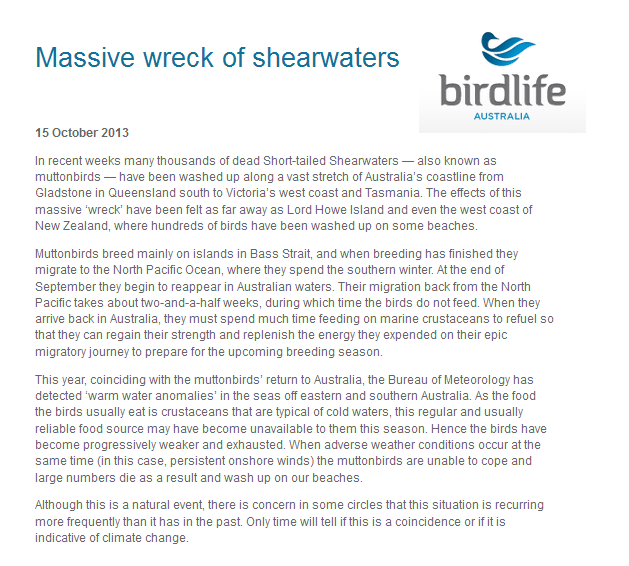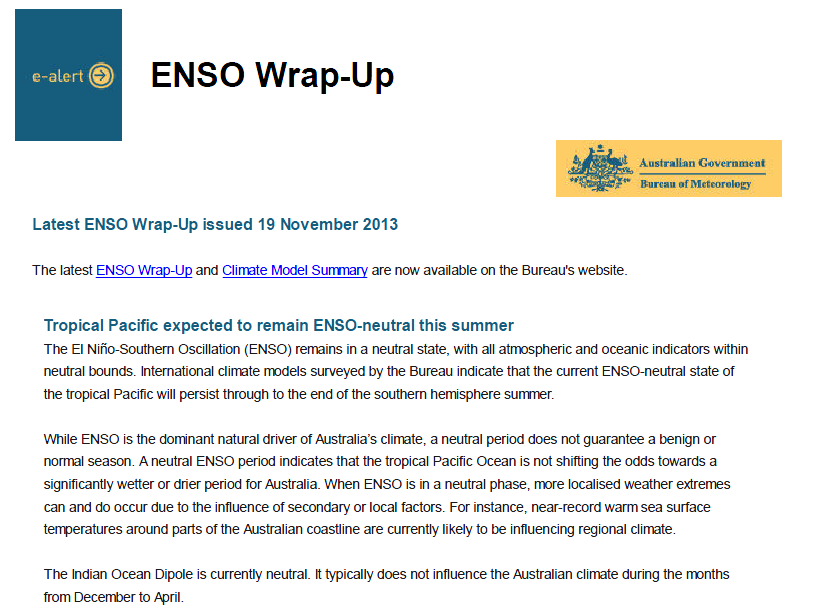Local weather extremes and poor food availability stretching our seabirds
It was about a month ago as I walked along Narrawong beach that I came to a standstill…dumbfounded at the sheer number of short-tailed shearwaters littered along the sand. I soon found that I was not alone in my observation.
For over a month now, there has continued to be a series of wash-up events of shearwaters across the south-eastern Australian coastline, often following strong winds and seas. I counted up to 100 birds within a 50 metre stretch, and reports from Port Fairy doubled this. Beachgoers may be somewhat used to this, with a number of shearwaters, particularly juveniles from the last breeding season often falling exhausted following their 1500km annual migration back from the Arctic and North Pacific Ocean in September to breed on our shores.
While conditions during their migration likely played a part, reports had already come in that the birds had arrived back to Australia before they washed up en-masse. Following their long migration, foraging in closer waters to replenish is vital before they start breeding. It appeared that something may have been affecting their ability to successfully feed locally.
It has not only been the short-tailed shearwaters that are doing it tough this season. The first dusk arrival count of the little penguin colony at Middle Island found a much smaller number of adult birds than what has been expected over the last few years. During breeding surveys this month, volunteers have also been shocked by the lack of breeding signs. One abandoned clutch of eggs and a handful of underweight adults have been found in surveyed nests – and not surprisingly, no sign of short-tailed shearwaters!
At other little penguin colonies across around the coast, including Phillip Island, the picture has been very similar. The Phillip Island Nature Park team have found so far only 30-50% of adults arriving nightly to the colony area compared to recent years, and a much lower number of breeding adults. The large number of abandoned eggs is thought to be due to parents not able to successfully take turns in incubating the eggs, as it is taking longer periods of time for adults to successfully forage at sea.
Melanie Wells, currently undertaking research on the Australasian Gannets at Point Danger has also found a much reduced number of adults returning to the colony, which are not breeding.
The Birdlife Australia article below explains that the combination of poor prey abundance due to warm water abnormalities and adverse weather conditions in our south-eastern seas may be to blame for such a large number of perilled shearwaters, and possibly for the poor start to the breeding season for the Little Penguin.
The Bureau of Meteorology (BOM) released further information on the localised abnormalities in sea surface temperatures and extreme weather, linking it to a current phase of a neutral El Niño Southern Oscillation (ENSO), which is the dominant driver of year to year climate variability for Australia and the wider equatorial Pacific. Warm surface waters could impact prey groups for these seabirds typical of cold waters such as crustaceans such as krill, and squid, by causing mass mortalities, poor spawning events, or causing migration of these prey away from areas available to the seabirds. A number of strong coastal winds and seas, particularly of south-easterly direction have been notable over the last few months.
So what impact does this event have on the colonies of these seabirds and for their species as a whole? All colonies or populations of a species will go through a natural fluctuations in survivorship and breeding success. Some seasons are favourable, others are not so, mostly depending on availability of resources. For our seabirds, offshore foraging success dictates not only their own survivorship, but the ability throughout the spring and summer months to successfully bring up offspring to contribute to the wider population.
Abnormality therefore is not necessarily a bad thing – one poor season may be balanced by a relatively good one….however an increase in the frequency and intensity of the conditions explained above may be cause for concern. Being able to discern between a natural ‘abnormality’ and a more direct effect from a changing climate is not an easily answered question.
The BOM has modelled how future climate predictions will affect ENSO, suggesting intensified and more frequent El Nino cycles, causing warmer ocean temperatures. It is thought that there is some level of effect of ENSO on the Bonney Upwelling, which boosts primary productivity along our south-eastern mainland coast through the upwelling of cold, nutrient rich water. Could changes to this upwelling occur and how would this affect our diverse range of sea-life? And if we are in a neutral ENSO phase now, how do we predict and account for localised extremes?
Research can only increase understanding and, while we cannot directly intervene on the scenario that has unfolded for now, it is as important as ever to continue to manage land based pressures and threats to these seabirds, notably to continue the hard work that goes into the Maremma Project. There is huge importance also in continuing to monitoring the Middle Island Penguin colony over the coming months to see what unfolds.

Continuing to manage land based threats and monitor colonies such as the Little Penguins at Middle Island is as important as ever
You can help and get involved as a Little Penguin Monitoring Volunteer. For any upcoming counts, please email me at if you would like to come along. The next count is on Monday 2nd December at 8.20pm. Please see the Volunteer-Guide_2013-14 for the full count schedule.




